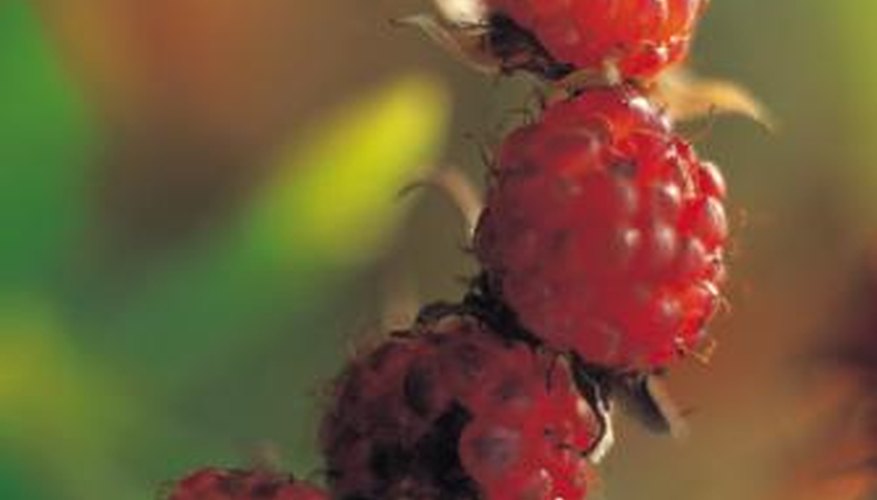Raspberries and blackberries grow on similar bushes and produce clusters of berries at the end of the summer. Raspberry plants are hardy, fast-growing cane plants that produce a large harvest when healthy, and picking raspberries can become a project for the whole family. If your raspberry leaves are yellowing, it's a sign of distress that can affect the size and quality of your harvest.
Chlorosis
There are two types of chlorosis that can affect raspberry leaves. If the leaves are yellow with green veins, the raspberry plant is suffering from an iron deficiency. Over time, iron deficiencies turn the leaves yellow and weaken the bush's production of new growth and raspberries later in the season. If the leaves are green with yellowing veins, the raspberry bush has veinal chlorosis, which is spread by nematodes and caused by a virus. It can stunt leaves and reduce the harvest size.
- There are two types of chlorosis that can affect raspberry leaves.
- If the leaves are green with yellowing veins, the raspberry bush has veinal chlorosis, which is spread by nematodes and caused by a virus.
Raspberry Mosaic Disease
Raspberry mosaic disease is a viral disease that causes a variety of problems for raspberry plants, including the mottled yellowing of leaves from which it draws its name. Other symptoms can include stunted growth, leaf blisters and brown tips on leaves, according to the University of Minnesota Extension. This disease is spread by the raspberry aphid. Pest control is crucial to preventing the contraction of the disease. Infection stunts growth and affects the quality of the raspberries.
- Raspberry mosaic disease is a viral disease that causes a variety of problems for raspberry plants, including the mottled yellowing of leaves from which it draws its name.
Root Rot
Phytophthora root rot is a fungal disease that affects the soil and roots of raspberry plants. As the disease progresses, the leaves of the raspberry bush will turn yellow around the edges and wilt or appear scorched, the University of Minnesota Extension reports. This disease kills raspberry canes and bushes in a short period of time. Treat the plant with a fungicide and remove any raspberry bushes that exhibit severe wilt and damage to stop the disease from spreading.
- Phytophthora root rot is a fungal disease that affects the soil and roots of raspberry plants.
- Treat the plant with a fungicide and remove any raspberry bushes that exhibit severe wilt and damage to stop the disease from spreading.
Pest Problems
Pest problems, including issues with aphids, Japanese beetles, raspberry cane borers and other insects, have the potential to cause the leaves of the raspberry plant to turn yellow in a short period of time. As insects feed on the plant, the leaves lose nutrients and are injured by the bites of the insects; both of these factors contribute to yellowing leaves and ragged edges, which weakens the plant. Apply a pesticide to the bush regularly to protect it from insects.
